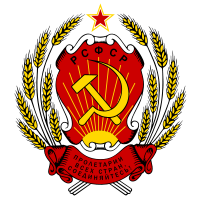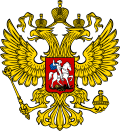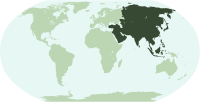- Coat of arms of Russia
-
The coat of arms of Russia have gone through three major periods in their history, undergoing major changes in the transitions between the Russian Empire, the Soviet Union, and the Russian Federation. They date back to 1472, when Ivan III began using the double-headed eagle in his seal, which, along with the image of St. George slaying a dragon, have been common in the coat of arms since. The coat of arms were changed in 1918 with the creation of the Russian Soviet Federative Socialist Republic, and depicted communist symbols such as the hammer and sickle and red star. The current coat of arms, in use since 1993, once again uses the double-headed eagle with the image of St. George.
Contents
Russian Empire
 The shield ("escutcheon") from the Great Coat of Arms of the Russian Empire
The shield ("escutcheon") from the Great Coat of Arms of the Russian Empire
The national symbols of the Russian Empire were the coat of arms and the state seal in three variants: great, middle and lesser.
Coat of arms
The coat of arms of the Russian Empire (Герб Российской Империи) consisted of a golden escutcheon with a black two-headed eagle crowned with two imperial crowns, over which the same third crown, enlarged, with two flying ends of the ribbon of the Order of Saint Andrew. The State Eagle held a golden scepter and golden globus cruciger. On the chest of the eagle there was an escutcheon with the arms of Moscow, depicting Saint George, mounted and defeating the dragon.
Great Coat of Arms
The depicted Great Coat of Arms (Russian: Большой государственный герб Российской Империи, Bol'shoy gosudarstvennîy gerb Rossiyskoy Imperii) was adopted in 1882, replacing the previous version of 1857. Tsar Alexander III first approved the relevant design on July 24, which, with minor modifications, was officially adopted on November 3.
Its central element is the coat of arms, crowned with the helmet of Alexander Nevsky, with black and golden mantling, and flanked by the archangels Michael and Gabriel. The collar of the Order of Saint Andrew is suspended from the coat of arms. The whole lies within a golden ermine mantle, crowned by Monomakh's Cap and decorated with black double-headed eagles. The inscription on the canopy reads: Съ Нами Богъ ("God is with us"). Above the canopy stands the state khorugv, of gold cloth, on which is depicted the Medium State Seal. The banner is topped by the State Eagle.
Around the central composition are placed fifteen coats of arms of the various territories of the Russian Empire. Nine of these are crowned and placed on a laurel and oak wreath. From left to right, these represent, as they are included in the full imperial title: the Khanate of Kazan, the Kingdom of Poland, Tauric Chersonesos, the unified coat of arms of the Grand Principalities of Kiev, Vladimir and Novgorod, the dynastic arms of the House of Holstein-Gottorp-Romanov, the Grand Principality of Finland, the Georgian principalities, and the Khanates of Siberia and Astrakhan.
The six upper escutcheons are joint depictions of various smaller principalities and oblasts. From left to right, these are: the combined arms of the northeastern regions (Perm, Volga Bulgaria, Vyatka, Kondinsky, Obdorsk), of Belorussia and Lithuania (Lithuania, Białystok, Samogitia, Polatsk, Vitebsk, Mstislavl), the provinces of Great Russia proper (Pskov, Smolensk, Tver, Nizhniy-Novgorod, Ryazan, Rostov, Yaroslavl, Belozersk, Udorsky), the arms of the southwestern regions (Volhyn, Podolsk, Chernigov), the Baltic provinces (Esthonia, Courland and Semigalia, Karelia, Livonia) and Turkestan.
Middle Coat of Arms
The Middle Coat of Arms (Средний государственный герб Российской Империи) is similar to the Great Coat of Arms, excluding the khorugv and the six upper escutcheons. The Abbreviated Imperial Title is inscribed over the perimeter of the Seal.
Lesser Coat of Arms
The Lesser Coat of Arms (Малый государственный герб Российской Империи) depicts the imperial double-headed eagle, as used in the coat of arms, with the addition of the collar of the Order of Saint Andrew around the escutcheon of St. George, and the Arms of Astrakhan, Siberia, Georgia, Finland, Kiev-Vladimir-Novgorod, Taurica, Poland and Kazan on the wings (seen clockwise).
History and evolution of the arms
The use of the double-headed eagle as a Russian coat of arms goes back to the 15th century. With the fall of Constantinople and the end of the Byzantine Empire in 1453, the Grand Dukes of Muscovy came to see themselves as the successors of the Byzantine heritage, a notion reinforced by the marriage of Ivan III to Sophia Paleologue (hence the expression "Third Rome" for Moscow and, by extension, for the whole of Imperial Russia). Ivan adopted the golden Byzantine double-headed eagle in his seal, first documented in 1472, marking his direct claim to the Roman imperial heritage and posing as a sovereign equal and rival to the Holy Roman Empire. In 1497 it was stamped on a charter of share and allotment of independent princes' possessions. At about the same time, the image of a gilt, double-headed eagle on a red background appeared on the walls of the Palace of Facets in the Moscow Kremlin.
The other main Russian coat of arms, the image of St George slaying the dragon, is contemporaneous. In its first form, as a rider armed with a spear, it is found in the seal of Vasili I of Moscow in 1390. At the time of Ivan III, the dragon was added, but the final association with Saint George was not made until 1730, when it was described as such in an Imperial decree. Eventually, St George became the patron saint of Moscow (and, by extension, of Russia).
After the assumption of the title of Tsar by Ivan IV, the two coats are found combined, with the eagle bearing an escutcheon depicting St George on the breast. With the establishment of the Moscow Patriarchate in 1589, a patriarchal cross was added for a time between the heads of the eagle.
In the beginning of the 17th century, with the ascension of the Romanov dynasty and its contacts with Western Europe, the image of the eagle changed. In 1625 for the first time the double-headed eagle appeared with three crowns. Traditionally, the latter have alternatively been interpreted as representing the conquered kingdoms of Kazan, Astrakhan and Siberia, as stated in the first edict concerning the state seal, on 14 December 1667, or as standing for the unity of Great Russia (Russia), Little Russia (the Ukraine) and White Russia (Belarus). Probably under influence from its German equivalent, the eagle, from 1654 onwards, was designed with spread wings and holding a scepter and orb in its claws.
During the reign of Peter the Great, further changes were made. The collar of the newly established Order of Saint Andrew was added around the central escutcheon, and the crowns were changed to the imperial pattern after his assumption of the imperial title in 1721. At about this time, the eagle's color was changed from golden to black, which would be retained until the fall of the Russian monarchy in 1917. A final form for the eagle was adopted by imperial decree in 1729, and remained virtually unchanged until 1853.
During the early 19th century, the eagle designs diversified, and two different variants were adopted by Emperor Nicholas I. The first type represented the eagle with spread wings, one crown, with an image of St.George on the breast and with a wreath and a thunderbolt in its claws. The second type followed the 1730 pattern, with the addition of the arms of Kazan, Astrakhan and Siberia on its left wing and those of Poland, the Taurica and Finland on the left one.
In 1855-57, in the course of a general heraldic reform, the eagle's appearance was changed, mirroring German patterns, while St George was made to look to the left, in accordance with the rules of Western heraldry. At the same time, the full set of coat of arms of Great, Medium and Minor Arms, was laid down and approved. The final revisions and changes were made in 1882-83, and are those described above.
Gallery
Soviet Union
State Emblem of the Russian Soviet Federative Socialist Republic 
Details Armiger  Government of the
Government of the
Russian Soviet Federative Socialist RepublicAdopted 10 July 1918 Escutcheon Baroque shield; Hammer and sickle Supporters Stalks of wheat Motto Workers of the world, unite! Other elements red star, rising sun,
acronym "PCФCP"The State Emblem of the Russian SFSR was adopted on 10 July 1918 by the government of the Russian Soviet Federative Socialist Republic, and modified several times afterwards. It shows symbols of agriculture (wheat) as well as a rising sun for the future of the Russian nation, the red star (the RSFSR was the last Soviet Republic to include star in its state emblem, in 1978) as well as the hammer and sickle for the victory of Communism and the "world-wide socialist community of states".
Overview
The banner bears the Soviet Union state motto ("Workers of the world, unite!") in Russian (Пролетарии всех стран, соединяйтесь! — Proletarii vsekh stran, soyedinyaytes!).
The acronym of the RSFSR is shown above the hammer and sickle, and reads PCФCP, for Российская Советская Федеративная Социалистическая Республика ("Russian Soviet Federative Socialist Republic").
Similar emblems were used by the Autonomous Socialist Soviet Republics (ASSR) within the Russian SFSR; the main differences were generally the use of the republic's acronym and the presence of the motto in the language(s) of the titular nations (with the exception of the state emblem of the Dagestan ASSR, which had the motto in eleven languages as there is no single Dagestani language).
In 1992 the inscription was changed from RSFSR (РСФСР) to the Russian Federation (Российская Федерация) in connection with the change of the name of the state.[1]
The state emblem was changed in 1993 to the present Coat of arms of Russia.
Gallery
The coat of arms of the Russian Federation  The heraldic device of the Russian Federation.
The heraldic device of the Russian Federation. Occasionally, the eagle found on the Federation's arms is used independently as an emblem. In appearance, this emblem itself resembles a full coat of arms.
Occasionally, the eagle found on the Federation's arms is used independently as an emblem. In appearance, this emblem itself resembles a full coat of arms.Information Date of origin 30 November 1993 Shield Gules a representation of Saint George upon horseback argent slaying a dragon. Crest and mantle An imperial crown or a coat of arms is placed on a shield gules. Supporters A two-headed eagle each head imperially crowned holding in its dexter talon a sceptre and in its sinister talon a globus cruciger Russian Federation
The coat of arms of the Russian Federation derives from the earlier arms of the Russian Empire, as restored in 1993 after the constitutional crisis. Though modified more than once since the reign of Ivan III (1462–1505), the current coat of arms is directly derived from its mediaeval original. The general chromatic layout corresponds to the early fifteenth century standard[citation needed]. The shape of the eagle can be traced back to the reign of Peter the Great (1682–1725), although the eagle in modern arms is gold instead of the imperial black.
Description
The two main elements of Russian state symbols (the two-headed eagle and the mounted figure slaying a serpent or dragon) predate Peter the Great. Today, however, the official description does not refer to the rider on the central shield as representing Saint George, mainly in order to maintain the secular character of the modern Russian state.
The current coat of arms was designed by artist Yevgeny Ukhnalyov; it was adopted officially on November 30, 1993 [1]. Today, the imperial crowns on each head stand for the unity and sovereignty of Russia, both as a whole and in its constituent republics and regions. The orb and sceptre grasped in the eagle's toes are traditional heraldic symbols of sovereign power and authority. They have been retained in the modern Russian arms despite the fact that the Russian Federation is not a monarchy, which led to objections by the Communists even though both the blue ribbon and the collar of the Order of St. Andrew (which in the imperial arms supported the three crowns and surrounded the central shield) have been removed from the current coat of arms.
The modern arms of Russia were instated by a presidential decree in 1993, and then by a federal law signed by President Vladimir Putin on December 20, 2000.
Gallery
-
Coat of arms of the Russian Federation after 1993
-
Coat of arms of Russia, photographed at the Consulate-General of Russia in Houston
-
Five double-headed Russian coat-of-arms eagles (below) substituting the former state emblem of the Soviet Union and the “CCCP” letters (above) in the facade of the Grand Kremlin Palace
See also
- National emblems of the Russian Empire
- Coat of arms of the Russian SFSR
- State Emblem of the Soviet Union
- Coat of arms of Moscow
- Flag of Russia
References
- The Greater Coat of Arms of the Russian Empire with Full Blazon Russian College of Heraldry
- The evolution of the Coat of Arms of Russia
- (Russian) Heraldry of the Russian Empire
- (Russian) The Code of Principal Laws of the Russian Empire (Свод Основных Государственных Законов, 1906)
- ^ The law of the Russian Federation from April 21, 1992 № 2708-I «About changes and additions of the Constitution (Basic law) of the Russian SFSR»
External links
 Coats of arms of the Soviet Union and Soviet Republics
Coats of arms of the Soviet Union and Soviet Republics Armenian SSR · Azerbaijan SSR · Byelorussian SSR · Estonian SSR · Georgian SSR · Kazakh SSR · Kirghiz SSR · Latvian SSR · Lithuanian SSR · Moldavian SSR · Russian SFSR · Tajik SSR · Turkmen SSR · Ukrainian SSR · Uzbek SSR
Armenian SSR · Azerbaijan SSR · Byelorussian SSR · Estonian SSR · Georgian SSR · Kazakh SSR · Kirghiz SSR · Latvian SSR · Lithuanian SSR · Moldavian SSR · Russian SFSR · Tajik SSR · Turkmen SSR · Ukrainian SSR · Uzbek SSRCoats of arms of the republics of Russia Coats of arms of Europe Sovereign
states- Albania
- Andorra
- Armenia
- Austria
- Azerbaijan
- Belarus
- Belgium
- Bosnia and Herzegovina
- Bulgaria
- Croatia
- Cyprus
- Czech Republic
- Denmark
- Estonia
- Finland
- France
- Georgia
- Germany
- Greece
- Hungary
- Iceland
- Ireland
- Italy
- Kazakhstan
- Latvia
- Liechtenstein
- Lithuania
- Luxembourg
- Macedonia
- Malta
- Moldova
- Monaco
- Montenegro
- Netherlands
- Norway
- Poland
- Portugal
- Romania
- Russia
- San Marino
- Serbia
- Slovakia
- Slovenia
- Spain
- Sweden
- Switzerland
- Turkey
- Ukraine
- United Kingdom
- (England
- Northern Ireland
- Scotland
- Wales)
- Vatican City
States with limited
recognition- Abkhazia
- Kosovo
- Nagorno-Karabakh
- Northern Cyprus
- South Ossetia
- Transnistria
Dependencies
and other territories- Åland
- Faroe Islands
- Gibraltar
- Guernsey
- Jan Mayen
- Jersey
- Isle of Man
- Svalbard
Other entities National emblems and coats of arms of Asia Sovereign
states- Afghanistan
- Armenia
- Azerbaijan
- Bahrain
- Bangladesh
- Bhutan
- Brunei
- Burma (Myanmar)
- Cambodia
- People's Republic of China
- Cyprus
- East Timor (Timor-Leste)
- Egypt
- Georgia
- India
- Indonesia
- Iran
- Iraq
- Israel
- Japan
- Jordan
- Kazakhstan
- North Korea
- South Korea
- Kuwait
- Kyrgyzstan
- Laos
- Lebanon
- Malaysia
- Maldives
- Mongolia
- Nepal
- Oman
- Pakistan
- Philippines
- Qatar
- Russia
- Saudi Arabia
- Singapore
- Sri Lanka
- Syria
- Tajikistan
- Thailand
- Turkey
- Turkmenistan
- United Arab Emirates
- Uzbekistan
- Vietnam
- Yemen

States with limited
recognition- Abkhazia
- Nagorno-Karabakh
- Northern Cyprus
- Palestine
- Republic of China (Taiwan)
- South Ossetia
Dependencies and
other territoriesCategories:- Russian coats of arms
- National coats of arms
- National symbols of Russia
Wikimedia Foundation. 2010.




















